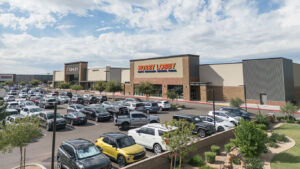Among his accomplishments, Casey Cartier, president and CEO of Jokake, has been named ASA Superintendent of the Year, voted Top 20 Under 40 Construction Leaders by ENR Southwest Magazine, and has led one of two construction divisions for Ryan’s Southwest regional office.
Now at the helm of Jokake’s Southwest regional construction divisions, Cartier manages corporate operations and keeps his eyes firmly fixed on the latest trends in commercial real estate. And, according to Cartier’s future commercial real estate scan, e-commerce will lead the way into the new year, with manufacturing and data centers trailing close behind.
“We are certainly focused on the industrial and manufacturing sector, with an intense focus on e-commerce opportunities,” Cartier explains. “One of the secondary areas of growth we’ll see in the Greater Phoenix area, in particular, is the Phoenix-Mesa Gateway Airport market.”
Growth indeed. With an already firm foundation of aerospace manufacturing with heavy-hitters such as Raytheon, Honeywell Aerospace, General Dynamics, The Boeing Company and Northrop Grumman Innovation Systems, Greater Phoenix is an emerging hub of innovative activity with a robust ecosystem of technology and software companies. While these nationally-recognized companies attract more aerospace manufacturing, there is great potential for additional advanced manufacturing and e-commerce opportunities in the 360 acres of SkyBridge commercial development at Phoenix-Mesa Gateway Airport.
Growth sectors

Cartier says manufacturing and distribution will continue to grow exponentially across the Valley and Tucson. The scattering of Amazon fulfillment centers, combined with Ten Distribution Center’s 1.1 million-square-foot speculative industrial project, and nine million square feet of cold storage distribution for leading grocers such as Sprouts Farmers Market are just a few examples of how Arizona is meeting the demand for diverse manufacturing and distribution.
According to Cartier, it’s not only mega distribution centers that are expected to expand.
“In addition to the major distribution hubs, we’ll see growth in secondary distribution warehouses as the demand for the fast delivery of goods continues to increase,” he says.
A recent example of secondary distribution is Jokake’s in-progress development of just under 40 test kitchens for Blue Apron.
Alongside manufacturing, Cartier foresees the data center market remaining a hot-space for growth.
Currently, Phoenix ranks second as the most active market in data center leasing in the U.S., outranking Dallas-Fort Worth and Silicon Valley.
“We have a great interest for data centers throughout all seven states that we serve,” Cartier says. “Where these prospective businesses will land specifically, will be based purely on usage rates for the area.”
Prime time
As a result of its stable climate, Greater Phoenix offers the potential to reduce the amount of energy necessary to operate mission-critical operations. This, coupled with a low risk of natural disasters, make the region a prime location for mission-critical operations.
Cartier says Arizona will likely capture its slice of pie across the board when it comes to manufacturing, distribution, data centers and e-commerce because of prime positioning.
“We are looking at in-fill opportunities that involve repurposing existing buildings for logistics purposes, putting us at a great advantage,” Cartier says.
While Arizona braces itself for advantageous
opportunities in the industrial space, are there any challenges the commercial real estate industry will encounter?
“I don’t know if we can begin to imagine surprises after the recent history of tariffs and labor demands,” Cartier says, “but if we look at the recent Mexico deal that kept additional tariffs from being placed as a hopeful indicator of the future, then some normalcy and predictability coming back to the industry would be positive surprise.”
Cartier’s hope, which most likely matches the desires of the commercial real estate community at large, is that labor supply and demand will return to “business as usual.”
“Normally, you’d see the material side related to inflation, but the tariff impacts were really a big hit in the real estate industry,” Cartier explains. “The cost impact of labor was anticipated to slow, but it didn’t. Now, economists are projecting a deceleration in our area, which is good.”
Cartier also adds that the real estate industry may have a helpful ally in the midst of navigating the challenges presented by labor and tariffs, and one most may not expect — technology.
“The design and construction components of the real estate market are making huge strides with technology,” Cartier says. “At Jokake, specifically, we are integrating the use of artificial intelligence in our processes. This is helping with the labor shortage, but more importantly, it is allowing us to be more creative with solutions and assist our clients when the project doesn’t appear to work financially.”



